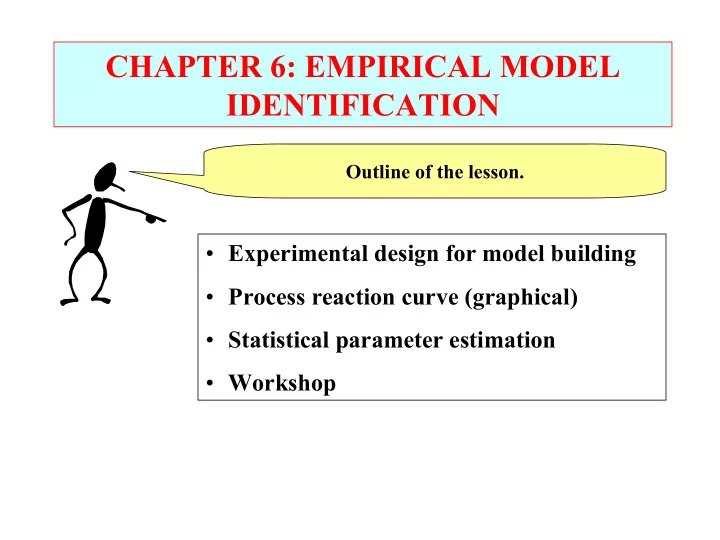

CHAPTER 6: EMPIRICAL MODEL IDENTIFICATION Outline of the lesson. • Experimental design for model building • Process reaction curve (graphical) • Statistical parameter estimation • Workshop
CHAPTER 6: EMPIRICAL MODELLING We have invested a lot of effort to learn fundamental modelling. Why are we now learning about an empirical approach? TRUE/FALSE QUESTIONS • We have all data needed to develop a fundamental model of a complex process • We have the time to develop a fundamental model of a complex process • Experiments are easy to perform in a chemical process • We need very accurate models for control engineering
CHAPTER 6: EMPIRICAL MODELLING We have invested a lot of effort to learn fundamental modelling. Why are we now learning about an empirical approach? TRUE/FALSE QUESTIONS false • We have all data needed to develop a fundamental model of a complex process false • We have the time to develop a fundamental model of a complex process false • Experiments are easy to perform in a chemical process • We need very accurate models for control engineering false
EMPIRICAL MODEL BUILDING PROCEDURE Start A priori knowledge Experimental Design Not just process control Plant Experimentation Determine Model Structure Parameter Estimation Diagnostic Evaluation Alternative Model Verification data Complete
EMPIRICAL MODEL BUILDING PROCEDURE Start Looks very general; it is! Experimental Design However, we still need to Plant Experimentation understand the process! Determine Model Structure Parameter Estimation Diagnostic Evaluation T Model Verification A Complete • Changing the temperature 10 K in a ethane pyrolysis reactor is allowed. • Changing the temperature in a bio-reactor could kill micro-organisms
EMPIRICAL MODEL BUILDING PROCEDURE • Base case operating conditions Start • Definition of perturbation Experimental Design • Measures • Duration Plant Experimentation • Safely Determine Model Structure • Small effect on product quality • Small effect of profit Parameter Estimation Diagnostic Evaluation • We will stick with linear. • What order, dead time, etc? Model Verification Complete
EMPIRICAL MODEL BUILDING PROCEDURE Start Experimental Design Plant Experimentation • Gain, time constant, dead time ... Determine Model Structure Parameter Estimation • Does the model fit the data used to evaluate the parameters? Diagnostic Evaluation Model Verification • Does the model fit a new set of data not used in parameter Complete estimation.
EMPIRICAL MODEL BUILDING PROCEDURE Process reaction curve - The simplest and most often used method. Gives nice visual interpretation as well. 1. Start at steady state 2. Single step to input T 3. Collect data until steady state 4. Perform calculations
EMPIRICAL MODEL BUILDING PROCEDURE Process reaction curve - Method I 45 15 S = maximum slope 35 11 input variable in deviation (% open) output variable in deviation (K) ∆ 25 7 15 3 θ 5 -1 δ -5 -5 0 10 20 30 40 time (min) Data is plotted in deviation variables
EMPIRICAL MODEL BUILDING PROCEDURE Process reaction curve - Method I 45 15 S = maximum slope 35 11 input variable in deviation (% open) output variable in deviation (K) = ∆ δ K p / ∆ 25 7 τ = ∆ / S θ = shown in f igure 15 3 θ 5 -1 δ -5 -5 0 10 20 30 40 time (min) Data is plotted in deviation variables
EMPIRICAL MODEL BUILDING PROCEDURE Process reaction curve - Method II 45 15 35 11 input variable in deviation (% open) output variable in deviation (K) 0.63 ∆ ∆ 25 7 0.28 ∆ 15 3 5 -1 δ t 28% t 63% -5 -5 0 10 20 30 40 time (min) Data is plotted in deviation variables
EMPIRICAL MODEL BUILDING PROCEDURE Process reaction curve - Method II 45 15 = ∆ δ K p / 35 11 input variable in deviation (% open) τ = − 1 . 5 ( t t ) output variable in deviation (K) 63 % 28 % 0.63 ∆ θ = − τ t 63 % ∆ 25 7 0.28 ∆ 15 3 5 -1 δ t 28% t 63% -5 -5 0 10 20 30 40 time (min) Data is plotted in deviation variables
55 Let’s get get out the calculator and practice with this experimental data. 51 output variable, degrees C input variable, % open 47 43 55 39 45 0 10 20 30 40 time
EMPIRICAL MODEL BUILDING PROCEDURE Process reaction curve - Methods I and II The same experiment in either method! Method I Method II • Developed first • Developed in 1960’s • Prone to errors • Simple calculations because of evaluation of maximum slope
Recommend
More recommend